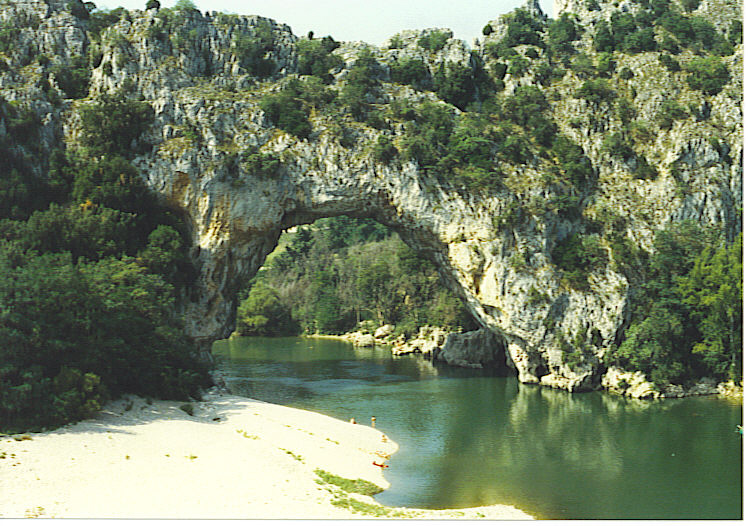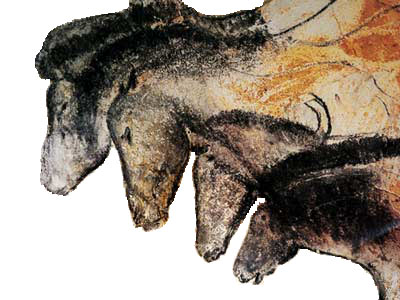
A new online Google exhibition called “Meet our Ancestors” opened this week. It allows viewers to explore cave paintings from one of the most exceptional Paleolithic discoveries – and one that is permanently closed to the public to ensure its preservation.
France’s Chauvet-Pont-d’Arc Cave was discovered in December 1994 and boasts one of the most important finds of prehistoric artwork. The cave, also known as the Grotte Chauvet-Pont d’Arc, named after the famous limestone bridge, has become in the thirty years since its discovery one of the most significant Paleolithic finds ever discovered. The cave was added as a UNESCO World Heritage Site in 2014.

Ardèche Pont D’Arc [Image Credit: Boerkevitz CC BY-SA 3.0]
The cave is located in a limestone plateau that has been carved into gorges by the Ardèche river. The cave contains artwork that dates back some 35,000 years. More than 1,000 images have been inventoried within the cave complex, and there may still be more regions yet to be catalogued.
What makes this cave extraordinary is that it appears to have had two periods of human habitation. Carbon dating conducted in 2016 suggests that the first period of human habitation occurred between 37,000 and 33,500 years ago. This first period is associated with the Aurignacian archeological tradition. They left behind torch marks, helping date the art. Most of the cave’s artwork comes from this period.
The second period of habitation occurred between 31,0000 and 28,000 years ago. This habitation involved the Gravettian archeological tradition, which disappeared just prior to the last glacial maximum, 17,000 years ago. The Gravettians who are known for their Venus figurines. The Gravettians left behind the remains of hearths and traces of their smoke, as well as a child’s footprint that may be the oldest in Europe.
Just after that child visited, a landslide completely sealed the cave. It remained untouched until its discovery in modernity.

Chauvet horses [public domain]
The artwork from both periods is exceptional. The artists portrayed a large array of creatures skillfully, adding dimensionality to their images through the use of shading. UNESCO describes the imagery as “of exceptional aesthetic quality, [demonstrating] a range of techniques including the skillful use of shading, combinations of paint and engraving, anatomical precision, three-dimensionality and movement.”
The artwork is broadly classified into two types: red and black. There is scientific disagreement about which culture is responsible for which set of paintings. Some scientists suggest that the red paintings appear to be from the earlier archeological period and the black drawings from the later archeological period, while others find that radiocarbon dating of animal bones and charcoal suggests the reverse.

Replica of Painting of Lions [public domain]
Regardless, the imagery is vast. The images include not only “several dangerous animal species difficult to observe at that time, such as mammoth, bear, cave lion, rhino, bison and auroch, as well as 4,000 inventoried remains of prehistoric fauna and a variety of human footprints,” but also anthropomorphic figures, Venus-like images, and what might even be a minotaur. Some cave art hints at a volcanic eruption spewing lava.
David Lewis-Williams, the South African archeologist, wrote in “The Mind in the Cave: Consciousness and the Origins of Art” that these caves were likely used for shamanic, magical, and/or ritual purposes. He understood these caves as resources of ancient spiritual power and devotional practice created by individuals who “saw real things, real spirit animals and beings, real transformations” on the cave walls.
Most of us cannot visit the Chauvet-Pont-d’Arc cave in person. The complex has been sealed to the public since shortly after its discovery. Scientific experience with other caves such as Altamira in Spain suggests that the unsealing of these caves, along with human visitors, can damage the artwork. Because of its sensitive state, the cave has been set for conservation and controlled visits that are exclusively for the purpose of scientific study.
Although an accurate life-size replica of the cave was opened in 2015, it requires a visit to Ardèche in the Vallon-Pont-d’Arc commune. It is the largest cave replica in the world.
Google stepped in to make the complex more accessible to the world, at least in a digital form. In collaboration with Syndicat Mixte de la Grotte Chauvet, Google has employed virtual reality and augmented reality to explore the delicate and famous cave and its artwork. One exhibit allows the viewer to walk through a 360 degree, three-dimensional tour of the Chauvet cave. Another exhibit, titled “Marauding Mammoths, Mysterious Footprints and the story of the Miraculous Discovery,” walks the viewer through the features of the cave and its 36,000-year history. The images are high resolution and feature closeups of the art, along with interpretive guidelines.
The virtual feature, called “The Dawn of Art,” was released last week. This requires a virtual headset, but for those who can have access to one, the view is amazing and the effects stunning. There is a short film, followed by a walk-through accompanied by Daisy Ridley (Rey from The Force Awakens, The Last Jedi, and The Rise of Skywalker). The whole experience is about 20 minutes. It’s well worth the time to explore what may be the cradle of human art.
The Wild Hunt is not responsible for links to external content.
To join a conversation on this post:
Visit our The Wild Hunt subreddit! Point your favorite browser to https://www.reddit.com/r/The_Wild_Hunt_News/, then click “JOIN”. Make sure to click the bell, too, to be notified of new articles posted to our subreddit.
